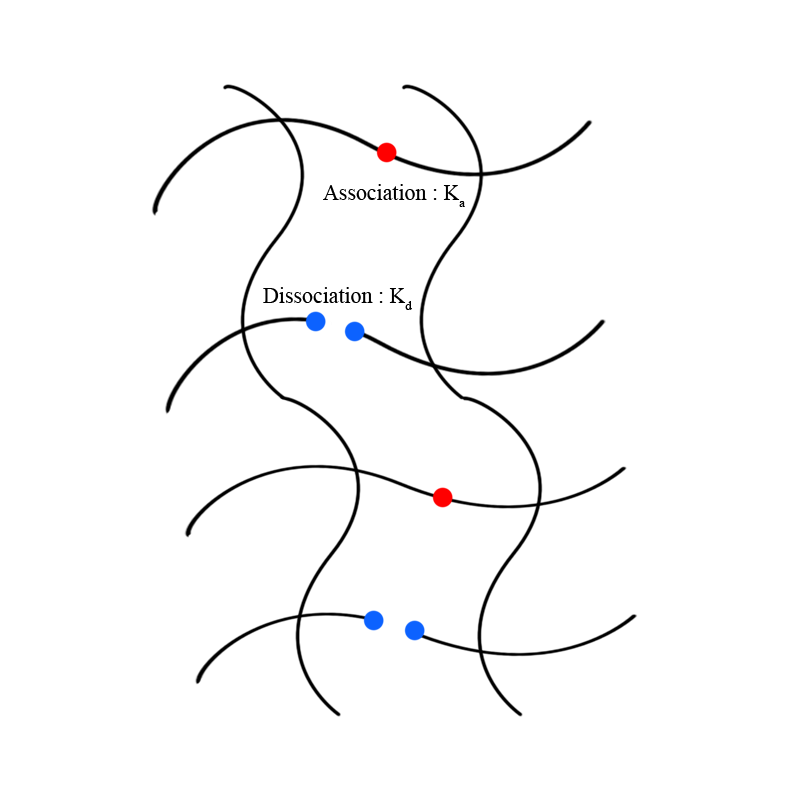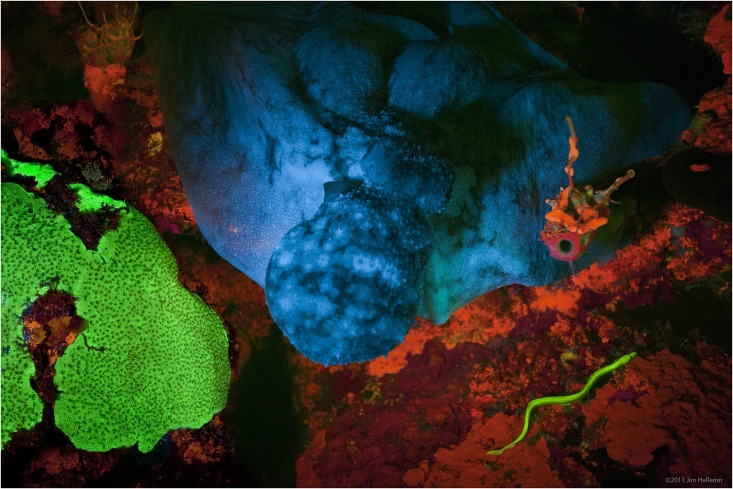|
J-aggregate
A J-aggregate is a type of dye with an absorption band that shifts to a longer wavelength (bathochromic shift) of increasing sharpness (higher absorption coefficient) when it aggregates under the influence of a solvent or additive or concentration as a result of supramolecular self-organisation. The dye can be characterized further by a small Stokes shift with a narrow band. The J in J-aggregate refers to E.E. Jelley who discovered the phenomenon in 1936. The dye is also called a Scheibe aggregate after G. Scheibe who also independently published on this topic in 1937. Scheibe and Jelley independently observed that in ethanol the dye PIC chloride has two broad absorption maxima at around 19,000 cm−1 and 20,500 cm−1 (526 and 488 nm respectively) and that in water a third sharp absorption maximum appears at 17,500 cm−1 (571 nm). The intensity of this band further increases on increasing concentration and on adding sodium chloride. In the oldest aggreg ... [...More Info...] [...Related Items...] OR: [Wikipedia] [Google] [Baidu] |
Supramolecular Polymer
The term "polymer" refers to large molecules whose structure is composed of multiple repeating units and the prefix "supra" meaning "beyond the limits of". Supramolecular polymers are a new category of polymers that can potentially be used for material applications beyond the limits of conventional polymers. By definition, supramolecular polymers are polymeric arrays of monomeric units that are connected by reversible and highly directional secondary interactions–that is, non-covalent bonds. These non-covalent interactions include van der Waals interactions, hydrogen bonding, Coulomb or ionic interactions, π-π stacking, metal coordination, halogen bonding, chalcogen bonding, and host–guest interaction. The direction and strength of the interactions are precisely tuned so that the array of molecules behaves as a polymer (that is, it behaves in a way that can be described by the theories of polymer physics) in dilute and concentrated solution, as well as in the bulk. I ... [...More Info...] [...Related Items...] OR: [Wikipedia] [Google] [Baidu] |
Merocyanine
Merocyanines are a class of polymethine dyes which are clearly defined by set structural properties. Merycyanines belong to the group of dyes referred to as functional dyes, where their applications are not only determined by their colour, but also their valuable chemical properties. These dyes are usually intensely colored and have large extinction coefficients. Merocyanine 540 was the first fluorescent dye used for measuring membrane potential, while Brooker's merocyanine and related compounds are notable for their solvatochromatic properties. : Definition :Conventionally, merocyanine class includes streptocyanines and their analogues where both the nitrogen atom and carbonyl group (or any other electron-withdrawing group containing a multiple carbon-heteroatomic bond, e.g. amino group) can form part of a heterocyclic system. Like ionic cyanines, merocyanines contain two terminal heteroatoms and a polymethine chain in their chromophores. See also * Brooker's merocyan ... [...More Info...] [...Related Items...] OR: [Wikipedia] [Google] [Baidu] |
Dyes
A dye is a colored substance that chemically bonds to the substrate to which it is being applied. This distinguishes dyes from pigments which do not chemically bind to the material they color. Dye is generally applied in an aqueous solution and may require a mordant to improve the fastness of the dye on the fiber. There are two broad categories of dyes: natural and synthetic; Natural dyes are dyes extracted from plants, Insects, or minerals. The majority of natural dyes are vegetable dyes derived from plant sources such as roots, berries, bark, leaves, and wood, as well as other biological sources like fungi. Synthetic dyes are also referred to as "coal tar dyes" because they are derived from substances that, until recently, could only be extracted from coal tar. A synthetic dye consists of a chromophore and an auxochrome added to a benzene derivative. Both dyes and pigments are colored, because they absorb only some wavelengths of visible light. Dyes are usually soluble i ... [...More Info...] [...Related Items...] OR: [Wikipedia] [Google] [Baidu] |
Fluorescence
Fluorescence is the emission of light by a substance that has absorbed light or other electromagnetic radiation. It is a form of luminescence. In most cases, the emitted light has a longer wavelength, and therefore a lower photon energy, than the absorbed radiation. A perceptible example of fluorescence occurs when the absorbed radiation is in the ultraviolet region of the electromagnetic spectrum (invisible to the human eye), while the emitted light is in the visible region; this gives the fluorescent substance a distinct color that can only be seen when the substance has been exposed to UV light. Fluorescent materials cease to glow nearly immediately when the radiation source stops, unlike phosphorescent materials, which continue to emit light for some time after. Fluorescence has many practical applications, including mineralogy, gemology, medicine, chemical sensors (fluorescence spectroscopy), fluorescent labelling, dyes, biological detectors, cosmic-ray detection, vacu ... [...More Info...] [...Related Items...] OR: [Wikipedia] [Google] [Baidu] |
Supramolecular Chemistry
Supramolecular chemistry refers to the branch of chemistry concerning chemical systems composed of a discrete number of molecules. The strength of the forces responsible for spatial organization of the system range from weak intermolecular forces, electrostatic charge, or hydrogen bonding to strong covalent bonding, provided that the electronic coupling strength remains small relative to the energy parameters of the component. While traditional chemistry concentrates on the covalent bond, supramolecular chemistry examines the weaker and reversible non-covalent interactions between molecules. These forces include hydrogen bonding, metal coordination, hydrophobic forces, van der Waals forces, pi–pi interactions and electrostatic effects. Important concepts advanced by supramolecular chemistry include molecular self-assembly, molecular folding, molecular recognition, host–guest chemistry, mechanically-interlocked molecular architectures, and dynamic covalent chemistry. The st ... [...More Info...] [...Related Items...] OR: [Wikipedia] [Google] [Baidu] |
Fluorescence
Fluorescence is the emission of light by a substance that has absorbed light or other electromagnetic radiation. It is a form of luminescence. In most cases, the emitted light has a longer wavelength, and therefore a lower photon energy, than the absorbed radiation. A perceptible example of fluorescence occurs when the absorbed radiation is in the ultraviolet region of the electromagnetic spectrum (invisible to the human eye), while the emitted light is in the visible region; this gives the fluorescent substance a distinct color that can only be seen when the substance has been exposed to UV light. Fluorescent materials cease to glow nearly immediately when the radiation source stops, unlike phosphorescent materials, which continue to emit light for some time after. Fluorescence has many practical applications, including mineralogy, gemology, medicine, chemical sensors (fluorescence spectroscopy), fluorescent labelling, dyes, biological detectors, cosmic-ray detection, vacu ... [...More Info...] [...Related Items...] OR: [Wikipedia] [Google] [Baidu] |
Hypsochromic Shift
Hypsochromic shift (from ancient Greek ὕψος (upsos) "height"; and χρῶμα ''chrōma'', "color") is a change of spectral band position in the absorption, reflectance, transmittance, or emission spectrum of a molecule to a shorter wavelength (higher frequency). Because the blue color in the visible spectrum has a shorter wavelength than most other colors, this effect is also commonly called a blue shift. This can occur because of a change in environmental conditions: for example, a change in solvent polarity will result in solvatochromism. A series of structurally related molecules in a substitution series can also show a hypsochromic shift. Hypsochromic shift is a phenomenon seen in ''molecular'' spectra, not ''atomic'' spectra - it is thus more common to speak of the movement of the peaks in the spectrum rather than lines. :\Delta\lambda = \lambda^_ - \lambda^_ where \lambda is the wavelength of the spectral peak of interest and \lambda^_ > \lambda^_ For example, β ... [...More Info...] [...Related Items...] OR: [Wikipedia] [Google] [Baidu] |
Fluorophore
A fluorophore (or fluorochrome, similarly to a chromophore) is a fluorescent chemical compound that can re-emit light upon light excitation. Fluorophores typically contain several combined aromatic groups, or planar or cyclic molecules with several π bonds. Fluorophores are sometimes used alone, as a tracer in fluids, as a dye for staining of certain structures, as a substrate of enzymes, or as a probe or indicator (when its fluorescence is affected by environmental aspects such as polarity or ions). More generally they are covalently bonded to a macromolecule, serving as a marker (or dye, or tag, or reporter) for affine or bioactive reagents (antibodies, peptides, nucleic acids). Fluorophores are notably used to stain tissues, cells, or materials in a variety of analytical methods, i.e., fluorescent imaging and spectroscopy. Fluorescein, via its amine-reactive isothiocyanate derivative fluorescein isothiocyanate (FITC), has been one of the most popular fluorophores. Fro ... [...More Info...] [...Related Items...] OR: [Wikipedia] [Google] [Baidu] |
Förster Resonance Energy Transfer
Förster resonance energy transfer (FRET), fluorescence resonance energy transfer, resonance energy transfer (RET) or electronic energy transfer (EET) is a mechanism describing energy transfer between two light-sensitive molecules ( chromophores). A donor chromophore, initially in its electronic excited state, may transfer energy to an acceptor chromophore through nonradiative dipole–dipole coupling. The efficiency of this energy transfer is inversely proportional to the sixth power of the distance between donor and acceptor, making FRET extremely sensitive to small changes in distance. Measurements of FRET efficiency can be used to determine if two fluorophores are within a certain distance of each other. Such measurements are used as a research tool in fields including biology and chemistry. FRET is analogous to near-field communication, in that the radius of interaction is much smaller than the wavelength of light emitted. In the near-field region, the excited chromophore e ... [...More Info...] [...Related Items...] OR: [Wikipedia] [Google] [Baidu] |
Alexa Fluor
The Alexa Fluor family of fluorescent dyes is a series of dyes invented by Molecular Probes, now a part of Thermo Fisher Scientific, and sold under the Invitrogen brand name. Alexa Fluor dyes are frequently used as cell and tissue labels in fluorescence microscopy and cell biology. Alexa Fluor dyes can be conjugated directly to primary antibodies or to secondary antibodies to amplify signal and sensitivity or other biomolecules. The excitation and emission spectra of the Alexa Fluor series cover the visible spectrum and extend into the infrared. The individual members of the family are numbered according roughly to their excitation maxima in nanometers. History Richard and Rosaria Haugland, the founders of Molecular Probes, are well known in biology and chemistry for their research into fluorescent dyes useful in biological research applications. At the time that Molecular Probes was founded, such products were largely unavailable commercially. A number of fluorescent dyes ... [...More Info...] [...Related Items...] OR: [Wikipedia] [Google] [Baidu] |



